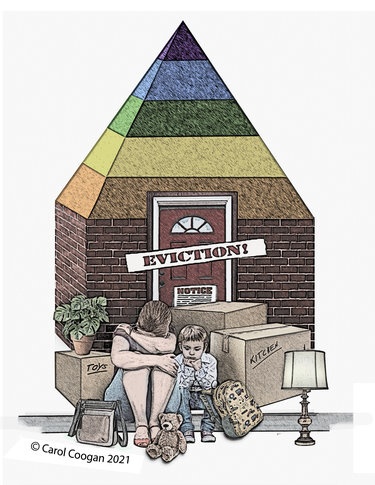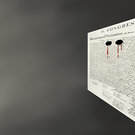A roof is also a foundation
Most of us learned about Maslow’s hierarchy in school, perhaps in a basic psychology class. But his theory has spread beyond academia into the common culture as a way to understand our needs and motivations as human beings.
Abraham Maslow published his paper, “A Theory of Human Motivation,” in the journal Psychological Review in 1943 and refined his theory over the decades until his death in 1970.
“It is quite true that man lives by bread alone — when there is no bread. But what happens to man’s desires when there is plenty of bread and when his belly is chronically filled?” Maslow wrote. “At once other (and ‘higher’) needs emerge and these, rather than physiological hungers, dominate the organism. And when these in turn are satisfied, again new (and still ‘higher’) needs emerge and so on. This is what we mean by saying that the basic human needs are organized into a hierarchy of relative prepotency.”
Maslow’s hierarchy is often portrayed as a pyramid. Physiological needs form that pyramid’s base. In order to survive, human beings need air, water, food, clothes, and shelter.
After those needs are met, next on the pyramid are safety needs, including emotional as well as physical, and financial security and the security that comes with good health. Next comes the need for love and social belonging followed by esteem, cognitive, and aesthetic needs and finally — at the top — comes self-actualization.
“What a man can be, he must be,” wrote Maslow. This means fulfilling our potential. “This tendency,” Maslow wrote of self-actualization, “might be phrased as the desire to become more and more what one is, to become everything that one is capable of becoming.”
We thought about Maslow’s hierarchy last week as we read and wrote about State Comptroller Thomas DiNapoli’s report, “New York State Rent Relief Funding.” The report laid bare the fact that billions of dollars in federal aid to help renters who fell behind during the pandemic were not getting to those who needed it.
If people don’t have their basic need for shelter met, they certainly can’t meet the next step of feeling safe. They cannot make larger contributions to our society, moving up the hierarchy, to benefit us all.
We listed in our story last week the comptroller’s recommendations for reaching the people who need these funds and we continue to endorse those recommendations.
Last Tuesday, Governor Kathy Hochul, on her first day in office, said she was meeting with the leaders of the state Assembly and Senate, launching a new targeted campaign on rent relief. Hochul said, too, that more staff was being assigned and a new campaign would reach more New Yorkers on rent relief. We applaud these efforts.
Then, last Thursday, the boom was lowered. The United States Supreme Court, in a majority decision, rejected the Biden administration’s moratorium on evictions. “If a federally imposed eviction moratorium is to continue, Congress must specifically authorize it,” the court ruled.
New York’s own moratorium was set to expire on Aug. 31. Hochul on Friday called for a special legislative session and on Tuesday announced one would be held the next day, Sept. 1.
“It is my goal to extend the eviction moratorium to expand rental assistance programs from today to January 15,” Hochul said on Tuesday.
“We are not going to abandon our neighbors in need, especially since the state of New York failed in its responsibility to get the money that was allocated by Congress out to the people in need earlier this summer,” she said. “Therefore, we want to expand the safety net for people who qualify for rental and landlord assistance, and we can no longer wait nor can they.”
Even without the lowered boom, the ship of state was in trouble. Last week, we wrote of a report that showed that the renter-wage gap in the United States has been worsening in recent years, even before the pandemic.
Many of the people who have been most likely to lose jobs or wages during the pandemic are also more likely to rent than to own their homes. Meanwhile, COVID-19 has driven housing prices higher for both renters and home buyers due to high demand and low supply. As a result, the typical renter has less to spend on housing that is becoming more expensive.
This is true across the United States — most drastically on the two coasts — as well as right here in the Albany area. Assuming full-time work and not being able to spend more than 30 percent of gross income on rent, renters cannot afford median rent for a one-bedroom rental in any large metropolitan area in the country.
The hourly wage needed to afford a one-bedroom rental in the Albany metro area is $18.92, the analysis said, but the estimated hourly wage for renters in Albany is just $13.77. This represents a gap of -27.2 percent.
Albany County, according to the comptroller’s report, has 142,884 households; more than a third — 52,331 households — are low-income. About the same number — 52,702 households — are rental.
Nearly a quarter of Albany County’s households — 33,695 — are low-income rental households and nearly a seventh of the county’s households — 20,135 — are low-income, rent-burdened households.
The comptroller’s analysis shows that, before the pandemic, the effects of low incomes and rent burdens fell disproportionately on non-whites, immigrants, and those who lack a college degree, many of whom worked in lower-wage industries. The pandemic has had a disproportionate impact on these same groups.
The crisis in paying rent is just one example of the ever-widening gap in our nation between the haves and the have-nots.
According to a recent report by the National Low Income Housing Coalition, median gross rents increased faster than median rental household income between 2001 and 2018 in 45 states and in Washington, D.C.
Only the highest wage earners have kept ahead of the rising rent costs.
Current full-time workers would need to earn nearly $21 per hour to afford a median-priced one-bedroom apartment without spending more than 30 percent of their income on rent but the estimated hourly wage for renters nationwide is just over $13 and the federal minimum wage has been locked in at $7.25 since 2009.
So this current crisis has shown us larger changes need to be made to have a sustainable society. Government should have a hand not just in solving the immediate crisis but in providing a more prosperous path forward, which is why we have supported not just the American Rescue Plan but the Jobs Plan and Families Plan as well.
This idea of our government’s role is not new in the United States. In 1854, Abraham Lincoln said, “The legitimate object of government is to do for a community of people, whatever they need to have done, but cannot do at all, or cannot so well do, for themselves, in their separate, and individual capacities.”
That tenet brings us back to Maslow’s work, nearly a century later. At age 30, before publishing his paper on the hierarchy, Maslow had lived at the Siksika Nation — also known as Blackfoot Indians — and studied the Siksikan way of life.
Ryan Heavy Head and the late Narcisse Blood, members of the Blackfoot Nation, received a grant from the Canadian government to research Sisikan influences on Maslow. Their lectures summarizing their findings are stored in the Blackfoot Digital Library, and have been interpreted by Teju Ravilochan.
In the Siksika Nation, Maslow found a place where 80 to 90 percent of the tribe had a quality of self-esteem that was found in only 5 to 10 percent of his own population.
“Maslow saw a place where what he would later call ‘self-actualization’ was the norm,” Heavy Head told Teju. This observation, Heavy Head said, “totally changed his trajectory.”
The term “self-actualization” does not exist in the Siksika language, but the closest word is niita’pitapi, which Heavy Head said means “someone who is completely developed, or who has arrived.”
To better understand this, Maslow sought out both positive deviants — successful members of the tribe — and negative deviants. He learned that the Siksika did not measure wealth by money or property but rather by generosity.
At the other end of the spectrum, Heavy Head and Blood learned, Maslow found that, “when someone was deviant, [the Siksika] didn’t peg them as deviant. A person who was deviant could redeem themselves in society’s eyes if they left that behavior behind.”
“Many First Nation cultures see the work of meeting basic needs, ensuring safety, and creating the conditions for the expression of purpose as a community responsibility, not an individual one,” writes Teju.
Heavy Head stressed that Maslow missed something important in his theory: the Indigenous relationship to place. “Without that, what he’s looking at as self-actualization doesn’t actually happen,” said Heavy Head. “There’s a reason people aren’t critical of their tribe: You’ve got to live with them forever.”
In 1966, Maslow wrote an essay called “Critique of Self-Actualization Theory” in which he said that self-actualization alone is not enough.
“Personal salvation and what is good for the person alone cannot be really understood in isolation,” he wrote. “The good of other people must be invoked as well as the good for oneself. It is quite clear that purely inter-psychic individualist psychology without reference to other people and social conditions is not adequate.”
So here we are, in the United States of America, in 2021, in a time and place where talk of tribalism usually means separate warring factions. Why not try to frame our future as being part of one entity?
“The good of other people must be invoked as well as the good for oneself,” wrote Maslow in the end.
Those who need the help — such as residents who can’t currently meet their rent because of the pandemic — should seek it. In early August, the county’s deputy commissioner of social services told us that, in Albany County, there are 31,000 rental households under the income limit and that, between the Hilltowns and Altamont, just 20 applications had been received.
If you have been hurt by the pandemic, you should apply for these funds. You have no doubt been paying taxes for years.
This is your money, from your government, to which you are entitled. It will help you to receive these funds and it will help your landlord too. If you have shelter and your basic needs are met, you can climb the hierarchy to a place that will benefit others.
If you apply to the rent relief program, you will automatically be protected from eviction while your application is pending.
The money is there. You need to use it.
And then you will be on secure footing to help us all build a better United States of America.


